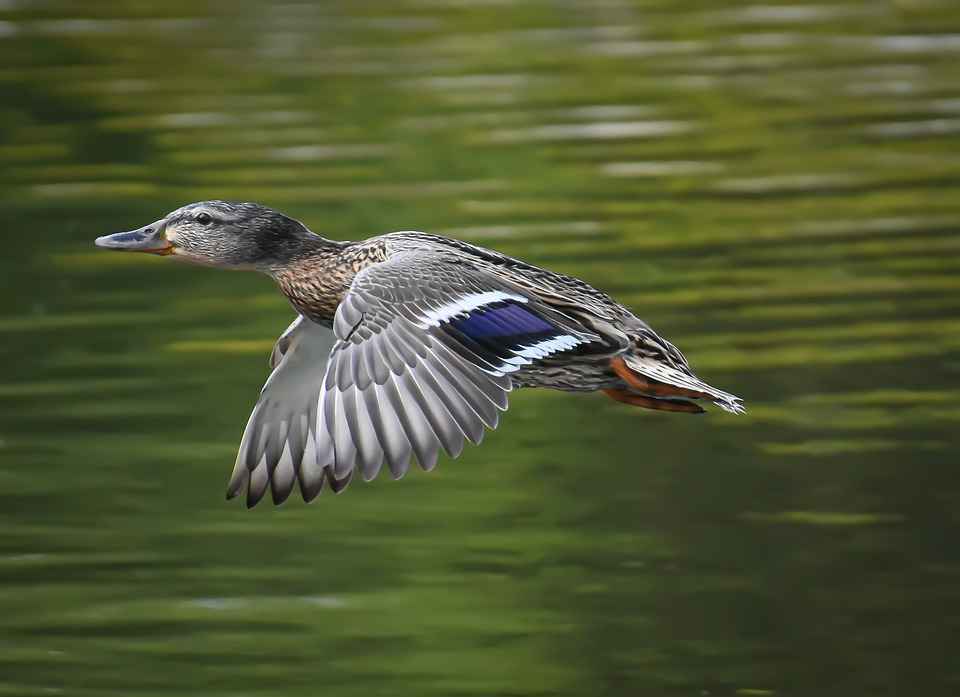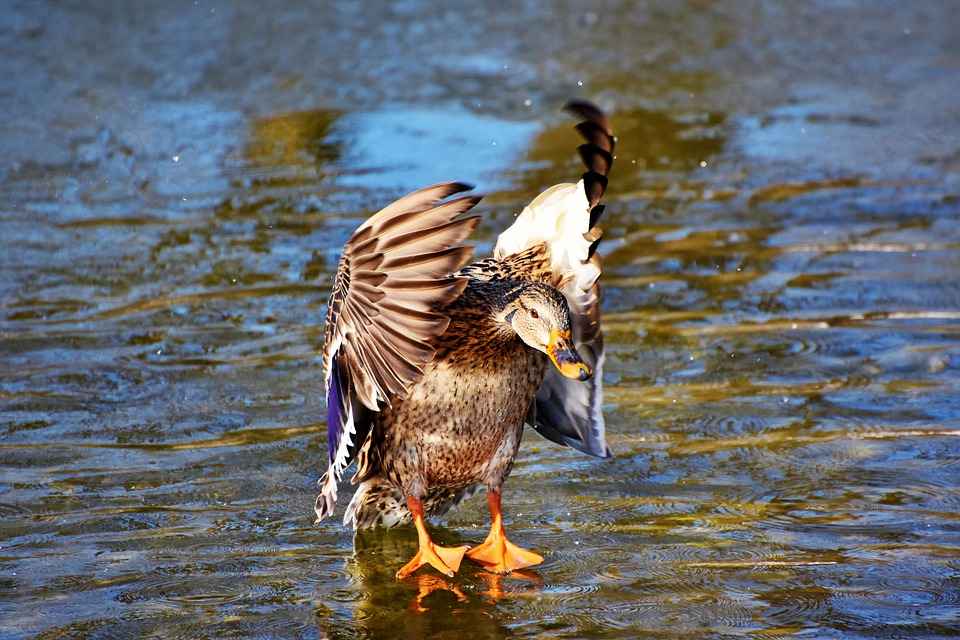 Ducks come in every shape and size. They live around the world, from wild habitats to suburban backyards and inner-city parks. Ducks come in a range of colors and even have different personalities depending on the species.
Ducks come in every shape and size. They live around the world, from wild habitats to suburban backyards and inner-city parks. Ducks come in a range of colors and even have different personalities depending on the species.
When we think of these birds, we may imagine a white bird with an orange beak and feet, like Donald Duck or Jemima Puddle-duck.
Did you know that these famous ducks are based on one particular species with a similar name to a popular Chinese cooking method? Read on to learn about these adorable birds and all about their Flying Abilities.
Can All Ducks Fly?
Not all ducks can fly, some ducks fly very well while others have no skill for flight due to their weight or specific breed characters.
It depends on the breed. Let’s see which ducks can fly and which ducks cannot in this article
Pekin Ducks
Pekin ducks are also called Aflac ducks. They are the stereotypical ducks we know so well. Pekins have white feathers that contrast with their orange beak and feet. They have plump and upright bodies.
Pekins are large ducks and they are also the fastest growing. They begin as yellow ducklings that fade to white and reach full size by two months of age.
Pekins are said to be the most common domestic ducks, and they can serve as pets or for production purposes. Pekin ducks are good layers because they tend to lay about 200 eggs a year.
Because they are so heavily domesticated, these birds are not very broody, which means their eggs can be easily collected. Pekins are also raised for meat.
They eat by foraging for weeds, grass and bugs. They were first bred in China several centuries ago. Importantly, the Pekin duck is not necessarily the variety used to make the Chinese Peking duck dish.
Both take their name from the former English name for Beijing. However, the dish is based on a cooking method, not the breed of bird.
Can Pekin ducks fly?
Pekin ducks will fly Rarely and not far. As domesticated birds bred for size, they are usually too heavy to fly and have no need to do so.
Nevertheless, these beautiful birds are not completely earth-bound. How well can Pekin ducks fly?
Depending on their weight, some lighter Pekins might be able to take off and fly short distances, in which case it may be recommended for their wings to be clipped.
Mallards
While Pekins rule the roost among domestic ducks, Mallards are the king of wild breeds. These ducks are small and light. Males have a green head, a gray body and a white ring that encircles their neck.
Females are less striking with their speckled brown plumage. Mallards eat by foraging for both insects and plant material.
Besides the plants, seeds, and insects they find in their wetland habitat, Mallards also consume grain like corn and oats. Mallards are the most abundant breed of wild duck in the northern hemisphere.
They can be found in the Americas, Euro Siberia, Northern Africa, and Asia. These ducks also thrive in Australia and New Zealand.
Mallards are, in fact, the original breed from which all other duck varieties can be traced, except the Muscovy—more on that later. Mallards lay from 60 to 120 eggs a year. They can be kept domestically, but it is recommended to keep those already born into captivity instead of taking them from the wild. Capturing wild Mallard is even illegal in some places.
Can Mallard ducks fly?
Yes, Mallard ducks can fly. This wild breed produces competent flyers, even in captivity.
They are also migratory birds, which means they have the habit of sustained flight at great distances and altitudes.

Muscovy Ducks
These unusual ducks, originating in South America, have a unique appearance due to their red “face masks” known as caruncles. They also have an unusual body shape, without the characteristic tail curl that all other male ducks develop. Beyond their physical appearances, these fowl also exhibit strange behavior.
Unlike other ducks, Muscovies perch like chickens and hiss rather than quacking.
These unique features have come about because Muscovies are actually not true ducks. These birds did not originate from Mallards like all other duck breeds. In fact, they are members of a separate species, and are more closely related to geese.
Muscovies can mate with standard ducks, but this produces sterile offspring called mule ducks. Muscovies come in a range of colors.
They can be dark brown, white, blue, bronze or magpie. These birds can be killed for food. They may be favored because their meat is leaner and more flavorsome than that of other ducks.
Their meat is similar to veal and sometimes even listed as red meat. Muscovies are heavy in comparison to other ducks, and their males are significantly larger than females. They lay 60 to 150 eggs per year. Muscovies eat plants and wetland insects, as well as small fish and reptiles.
Can Muscovy ducks fly?
Yes, Muscovies are able to fly, especially when living in the wild. However, as larger ducks, they generally cannot fly any great distance. Domestic Muscovies may fly within their immediate area and perch on rooftops. It is recommended for their wings to be clipped when kept in captivity.
Rouen Ducks
This variety, with its green-headed males and brown-speckled females, looks almost identical to the original Mallard. The main distinguishable difference is their size. Rouen ducks are up to three times larger and much heavier than Mallards. Like Mallards and Pekins, these birds have a calm and docile personality that makes them a good choice for a domestic setting.
Rouen ducks are reasonable egg layers, as they average approximately 150 eggs per year. Their eggs are green-tinged, similar to those of Mallards and Runners.
More importantly, Rouen ducks are prized for their meat, which is considered to be of excellent quality. These birds were first bred in France before the 1800s.
Can Rouen ducks fly?
No Rouen ducks can’t fly. Like other heavy ducks, Rouens are unable to fly. Particular birds resulting from cross-breeding Rouens with Mallards may be able to take off some distance, particularly if they are young and small.
Indian Runner Ducks
Runner ducks are an unusual duck to say the least. From their appearance, we can immediately see that these ducks are somewhat unique. Indian Runner ducks stand very upright, with tall and slim bodies.
They are sometimes compared to milk bottles or bowling pins. Their name refers to their manner of running, or shuffling, rather than waddling as other ducks do.
This unusual breed comes from Southeast Asia, although not necessarily from India, as their name would imply. These relatively small ducks were bred to eat insects from rice paddies. Runner ducks are active and have slightly a nervous disposition, which causes them to startle easily.
They are outstanding egg layers that produce 200 to 350 eggs a year. Indian Runner ducks come in many colors, including black, chocolate, blue, fawn, silver, and white. These ducks are omnivorous. They eat plant material such as grass and weed, as well as insects, slugs and worms.
Can Indian Runner ducks fly?
No, Indian Runner ducks cannot fly. Can runner ducks fly even short distances? Not at all. Particularly upright birds, including runner ducks and penguins, are not shaped for the physics of flying. This shape combines with their wing-strength in relation to their size. Even though Runner ducks may have proportionately large wings, they are still not able to lift themselves beyond taking small hops.
Campbell Ducks
These medium-sized ducks also go by the name of Khaki Campbell. They are named after Adele Campbell, who established the breed in Gloucester, early in the 1900s, by crossing Rouens, Runners and Mallards. Their relation to runners can be seen in their slender, slanted bodies. Like runners, they may also be slightly skittish.
Of course, Khaki Campbells can be of a “khaki” color.
Birds of this description are similar to their Mallard ancestors. The drake has a green head and brown or bronze body. The female is brown and speckled. Besides the Khaki variety, Campbells also come in dark and white plumage.
They are very productive birds to keep for meat and eggs. The breed was originally created for meat, and is still appreciated for that purpose. Campbells are also great for eggs. They lay up to 300 a year.
Can Khaki Campbell ducks fly?
Generally speaking, no, these Khaki Campbell ducks do not fly. However, there are rare reports of them flying limited distances. This shows that it is possible for them to do so.
Can all wild ducks fly?
Smaller wild duck breeds are the most competent flying ducks, and they can still fly in captivity unless their wings are clipped.

More Duck Flying Facts
Do ducks fly south for the winter
Yes, ducks are just one of many types of migratory birds. Waterfowl, in particular, need to fly south from countries where ponds and lakes might freeze over in the colder months. It may also become difficult for ducks to find adequate food during winter, as grass tends to die or go dormant and insects are less abundant.
Ducks migrate for other reasons, and at other times. For example, they appear to alter their movements to cut into the hunting season, as suggested in this news article concerning the habits of New Zealand ducks.
Migration patterns apply to wild ducks, such as Mallards. Domestic ducks have no need or desire to fly south. They should be provided with adequate food and a comfortable home by their owners throughout the year. As we have seen, most backyard ducks are generally poor flyers, and would not be capable of migrating even if they wished to.
How far can ducks fly
A duck’s ability to fly any distance depends on the breed of duck. We have already seen that Mallards are skilled in flight. Meanwhile heavier birds such as Pekins, Muscovies and Campbells may be able to fly short distances.
What ducks can’t fly? Rouen and runner ducks have no ability. Of those that are capable of extensive flight, Mallards can fly up to 800 miles in 8 hours in favorable wind while migrating. These wandering ducks regularly cross continents during their seasonal movements.
How fast do ducks fly
Ducks typically fly at speeds of 40 to 60 mph, according to the hunting and fishing advisors at Reelfoot. The same writers claim that the fastest duck on record managed to reach 100 mph.
This feat was achieved by a red-breasted merganser, which is a wild duck of the northern hemisphere. The second-best duck speed was a canvasback, which achieved 72 mph.
How high can ducks fly
Ducks, specifically Mallards, usually fly somewhere between the broad range of 200 and 4,000 feet. This happens during migration, which is when many birds reach their highest altitude.
The record lies with a Mallard that was once recorded at 21,000 feet over Nevada. Surprisingly, there appears to be another duck with an extraordinary habit of reaching even higher heights. Ruddy Shelducks fly as high up as 22,000 feet to cross parts of the Himalayas.
This is part of their migration to and from the northern side of the mountain range to below the Tibetan Plateau. For comparison, the bird capable of attaining the greatest altitude under any circumstances is the Ruppells Vulture. This African bird reaches 36,000-37,000 feet.
Can domestic ducks fly & Can domestic ducks survive in the wild
They can to some extent. There are many examples of ducks living in the wild after escaping or, sadly, being abandoned by their owners. However, ducks are similar to any animal because domestic varieties and individual animals raised by humans do not have the skills to thrive in nature.
One of the greatest challenges for domestic ducks is their inability to fly. This makes it hard for them to escape from predators.
Domestic varieties of duck can sometimes fly. They may need to have their wings clipped to avoid accidents or escape. Breeds that originated for meat and egg production tend to be larger and heavier. Domestication over many generations also affects the bird’s instinct and necessity for flight.
Can humans keep wild ducks
Just like Mallards, wild ducks can be kept by humans. However, these ducks are bred from domesticated strains and raised by duck breeders. They are often marked by their breeders to show that they have been raised domestically.
It is not a good idea to take wild birds directly from nature, and it may be against the law in some places. Domesticated ducks from wild breeds should certainly have their wings clipped if there is any chance of them flying away.






